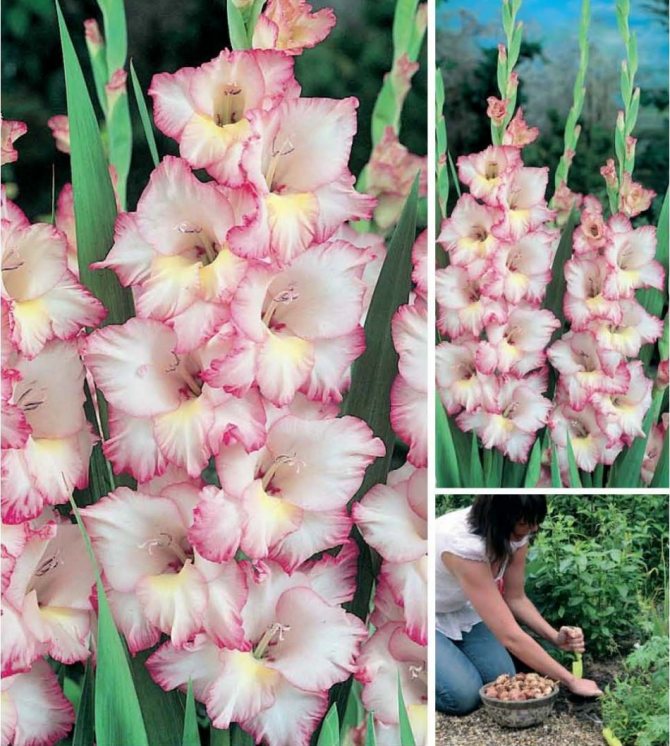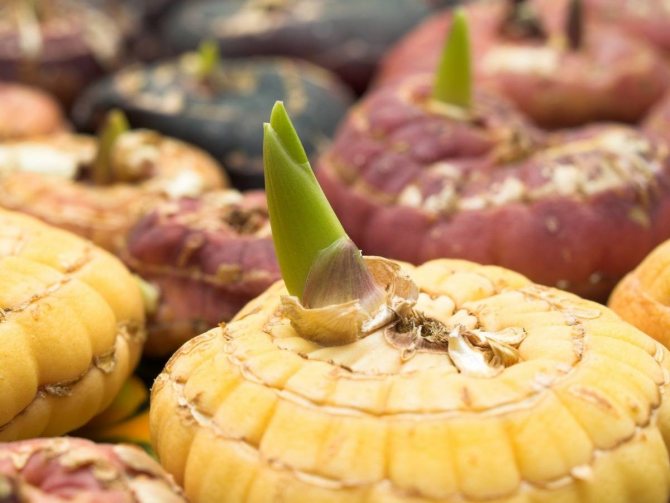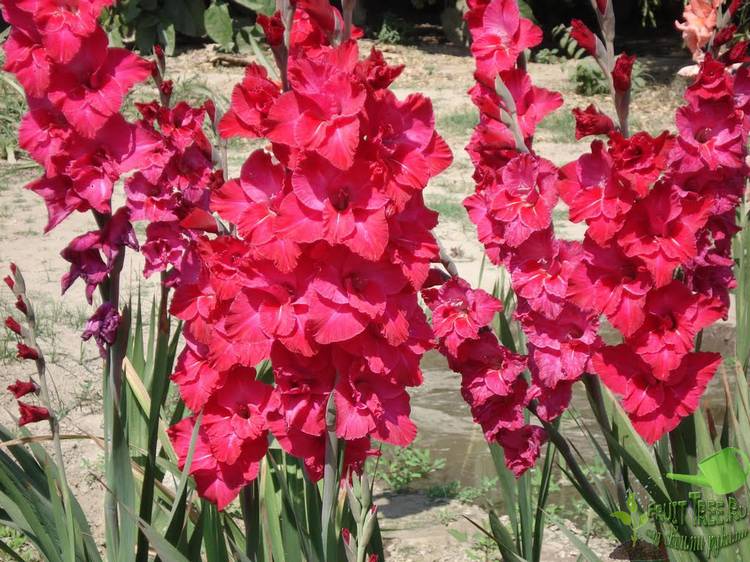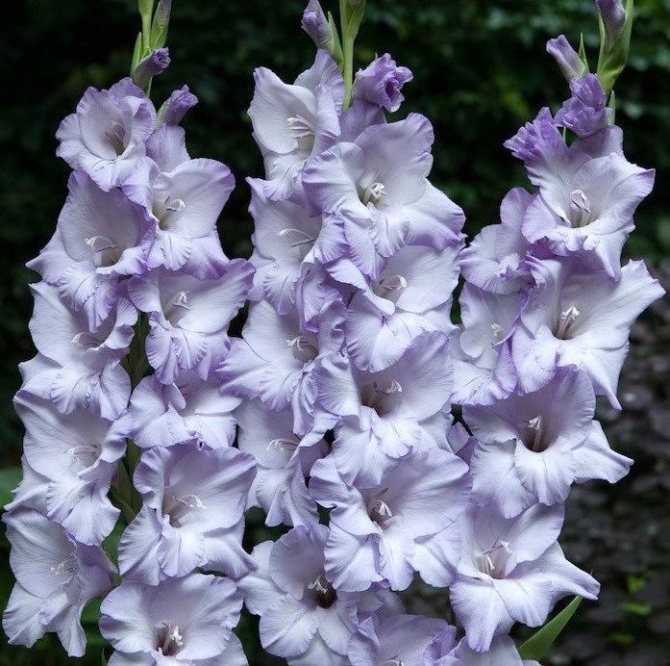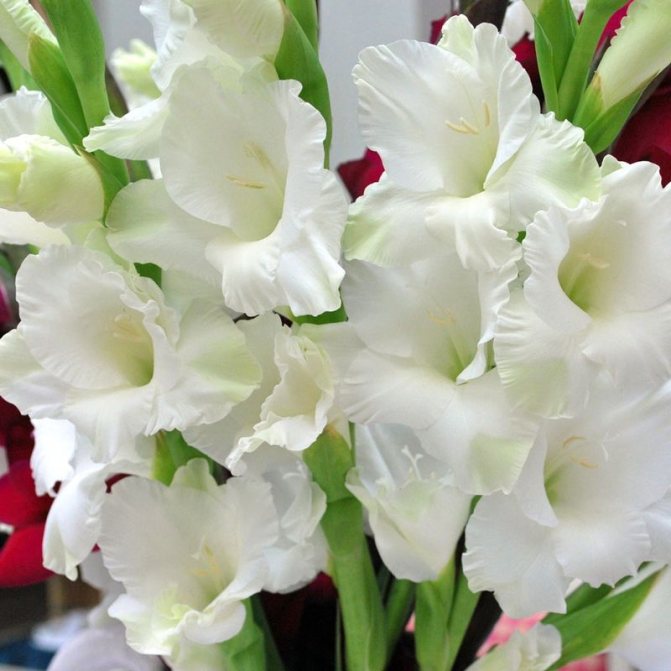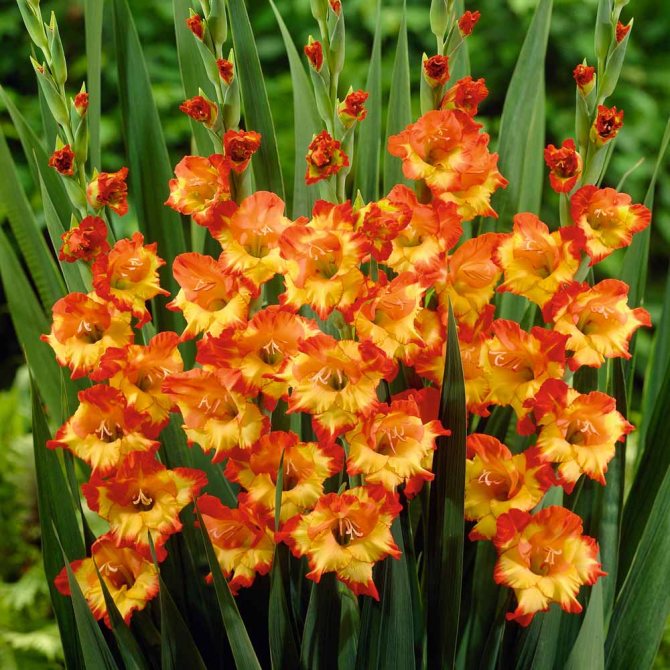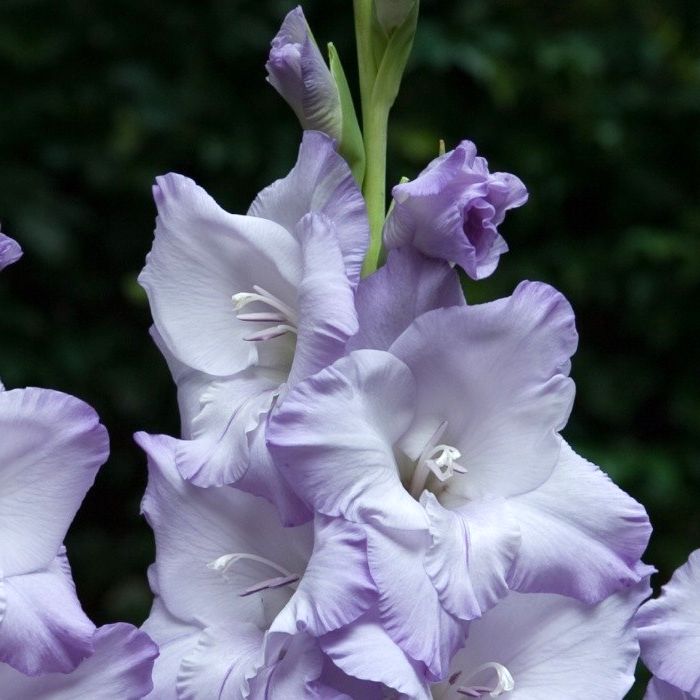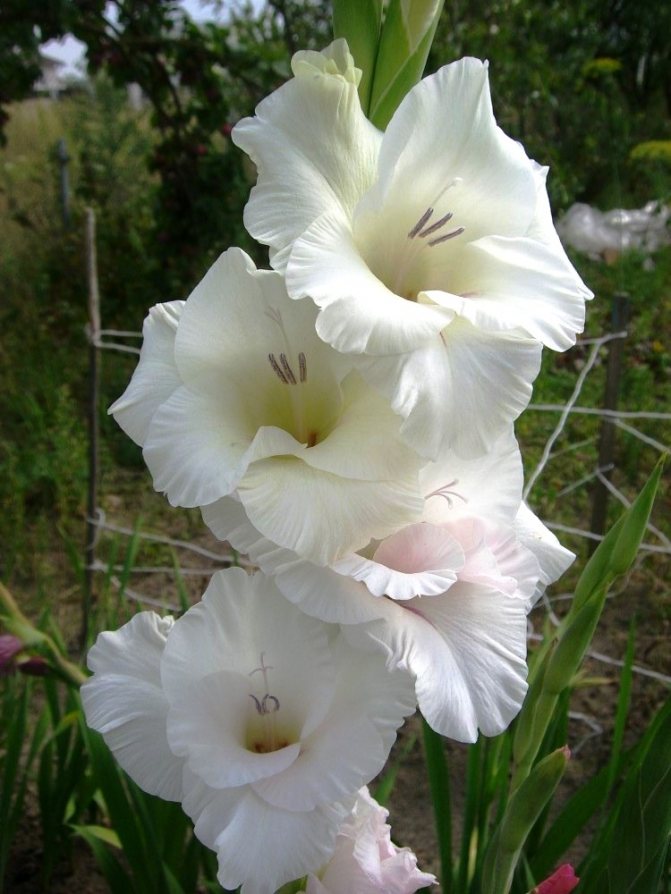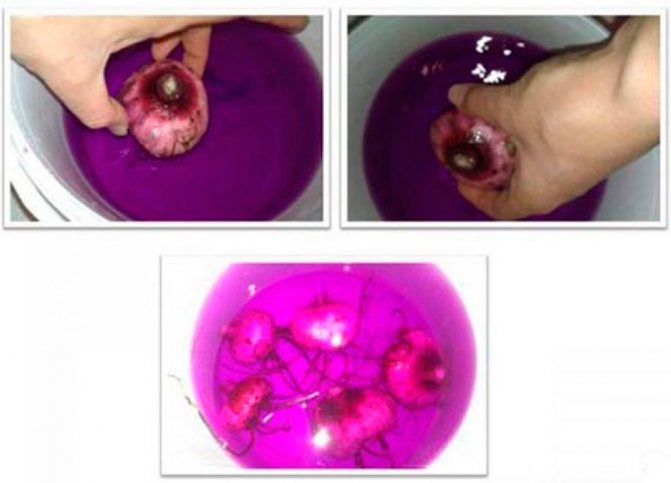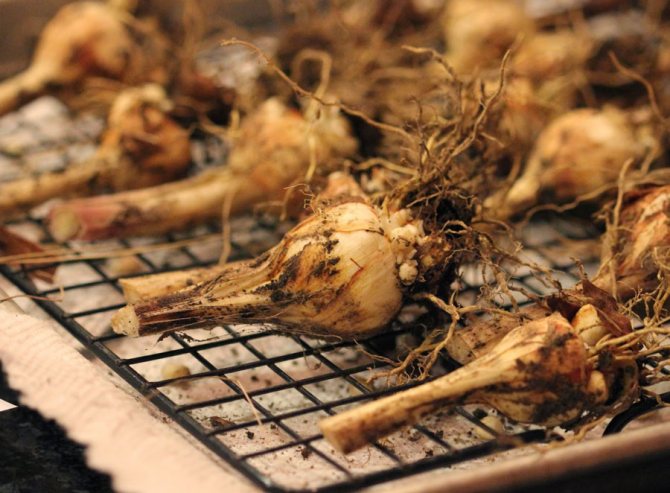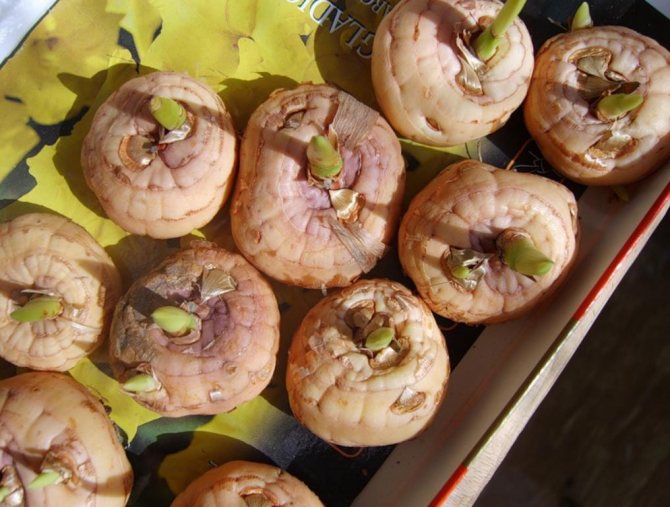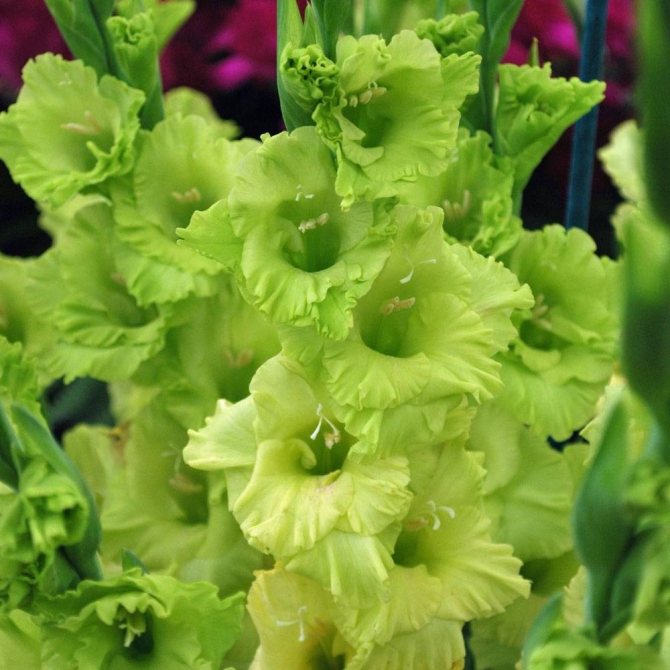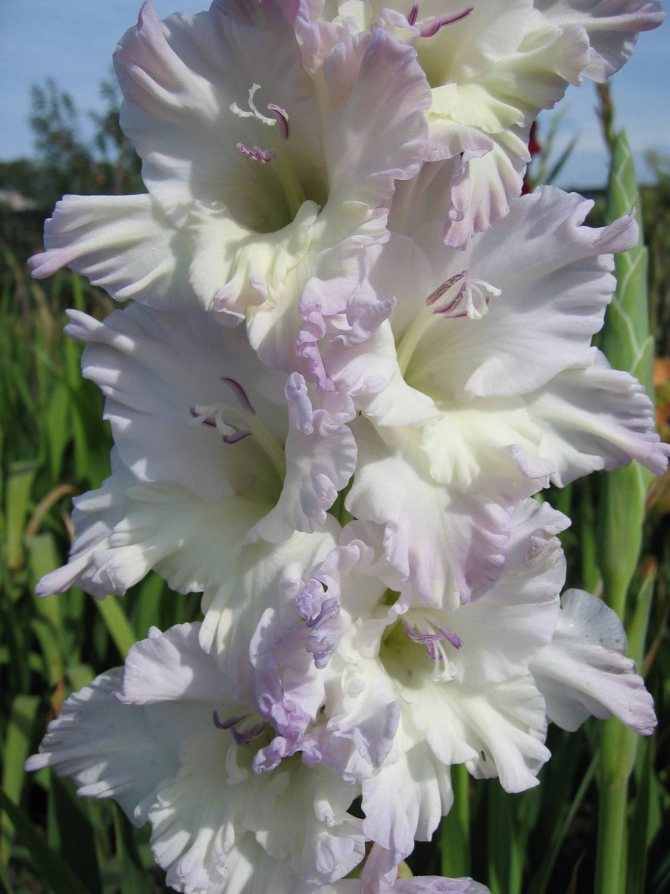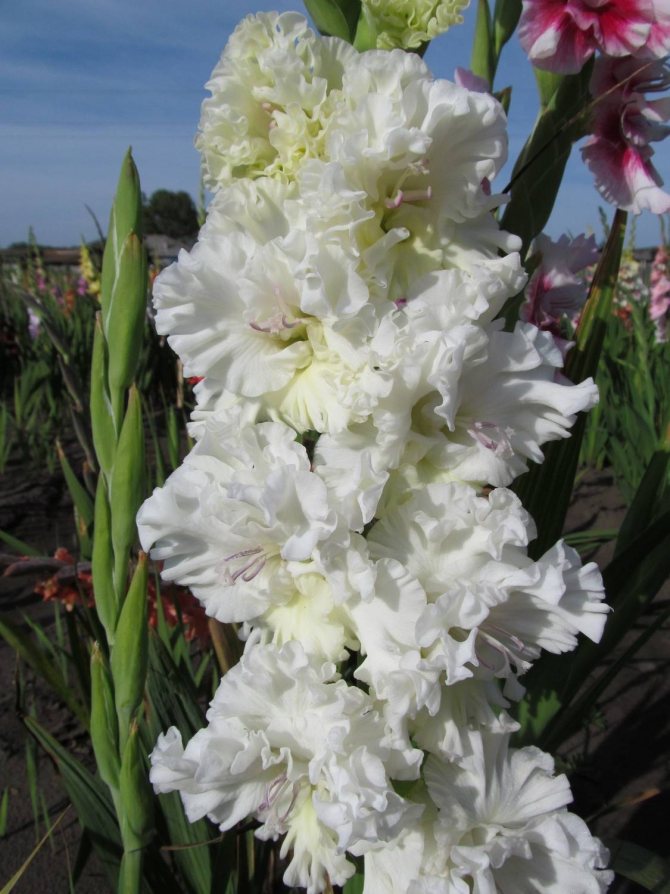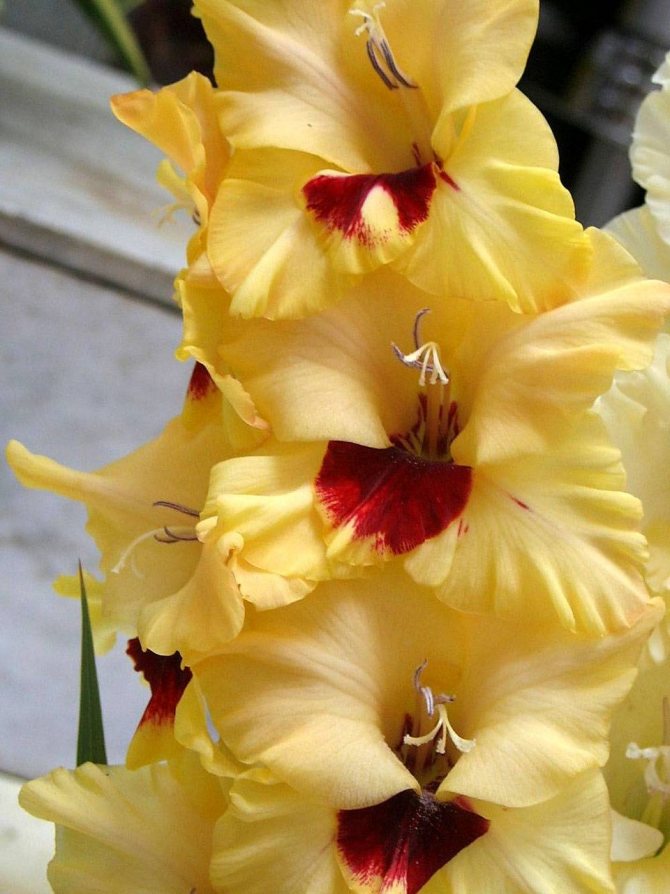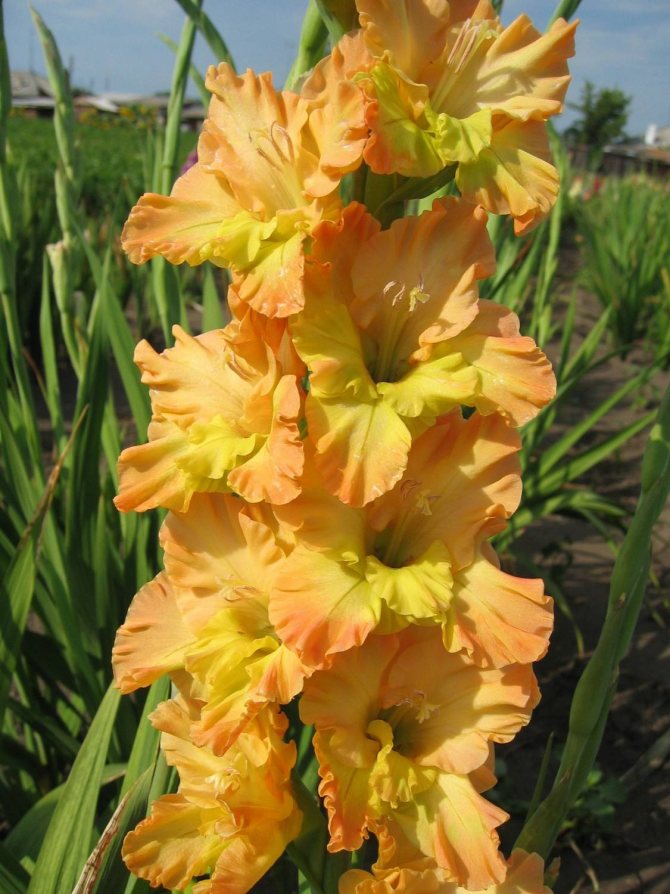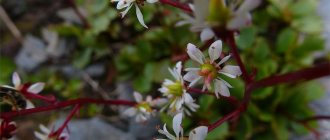What kind of flower - gladiolus
What is gladiolus? Gladiolus (Latin for "sword") is a perennial bulbous plant of the Iris family. The leaves, pointed at the ends, growing from the rhizome, have an average height of 40 to 80 cm. The straight, dense stem reaches one and a half meters in height, forming a spike-shaped inflorescence of 10 or more flowers. Funnel-shaped bisexual flowers, the size of which depends on the variety (3.5-15 cm), consist of 6 curved petals fused at the base. The color of the corollas is varied: from boiling white to deep burgundy or dark purple almost black.
The flower comes from Asia, Africa. Wild varieties are still found in Southern Europe, Western Siberia, and the Caucasus. It appeared on the European continent in Ancient Rome, where it was used for making male amulets and used for food. It gained popularity as an ornamental plant in the 18th century. In a relatively short period of time, breeders have bred about 200 species and about 5 thousand varieties.
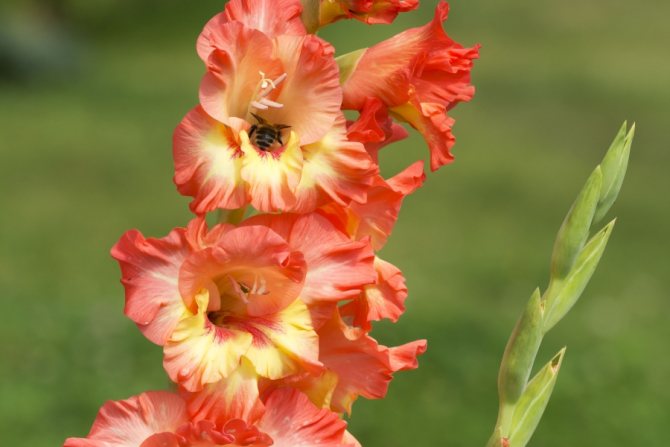
Gladiolus
For your information! Another name for the flower is a sword, since outwardly the gladiolus looks like a blade. The peduncle and leaves have this shape.
Hybrid gladiolus
- Butterfly hybrids... Plant height up to 120 cm, inflorescences reach 8 cm in diameter. Very beautiful flowers, strongly corrugated petals.
- Miniature Hybrids... Plant height up to 75 cm, flowers up to 5 cm in diameter.
- Primrose hybrids (Primulinus hibrids)... They differ in a variety of inflorescence colors. The diameter of the flowers can be up to 8 cm.
- Colorado group hybrids
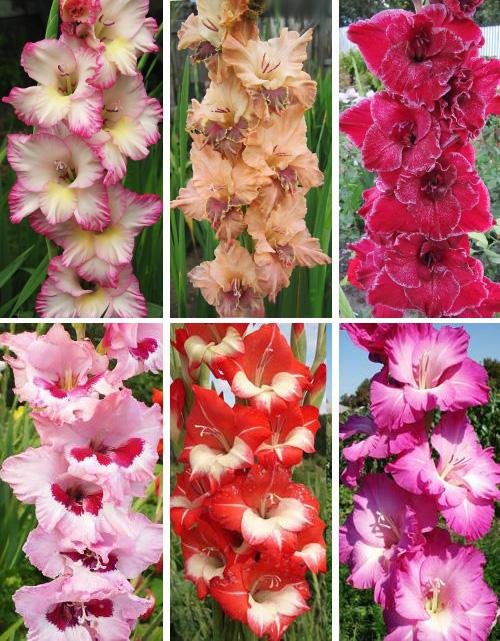

Similar articles:
- Lily
- Tulips
- Narcissus
- Hyacinth
Plant characteristic
Gladiolus varieties
The basis of the flower is the corm. After planting, it releases roots, buds. Root system changes occur throughout the season. The mother's bulb forms primary and retractor roots, the base of one of the buds transforms into a replacement corm, which creates offspring - tiny daughter bulbs.
The structure of the inflorescence is also interesting. Flowers can be arranged in 1 or 2 rows, on one side of the stem, or on two, in a spiral. By how often the flower funnels are located, the inflorescences are divided into:
- loose, with a large distance between the buds;
- medium-dense - when the petals of adjacent funnels barely touch;
- dense, when the blossoming corollas overlap each other.


Flower structure
Gladioli flowers are also subdivided according to the structure of the corolla, the size of the inflorescences, the timing of flowering, and the height.
Flowers similar to gladioli are also known to modern gardening:
- Crocosmia (montbrecia, tritonia, Japanese gladiolus, Chinese gladiolus) from the Iris family, native to Africa. It is a bulbous plant that forms panicle inflorescences with small flowers, stars or bells.
- Acidantera (gladiolus Murel, fragrant gladiolus, Ethiopian gladiolus) is "African" in origin. These are stellate flowers with uniform petals, which are collected in a spike-shaped inflorescence, very odorous.
Some gardeners see similarities with gladioli in delphiniums, irises, lilies, orchids.
How to plant correctly
In the dug soil, a furrow is made with a depth of 15-20 centimeters, it all depends on your soil, the lighter it is, the deeper you need to plant the onion.If planted too deep, the gladiolus may not bloom at all, if at the top, it may begin to collapse under its own weight and will have to be supported.
Sand is poured at the bottom of the furrow or you can pave it with sphagnum, be sure to spill dry soil with water.
Plant the bulbs at a distance of 7-15 cm from each other, it all depends on the size, the larger the tuber, the more space is needed accordingly. Children are planted after 3-5cm. Necessarily separate from adults, since they will take all the nutrients from the soil and children will not be able to develop.
Observe the dimension of the bulbs when planting. The largest and strongest specimens put in a separate place.
From above, the garden bed can be covered with compost or peat chips, it can be covered with a film for a while, for rapid growth.
Types and varieties
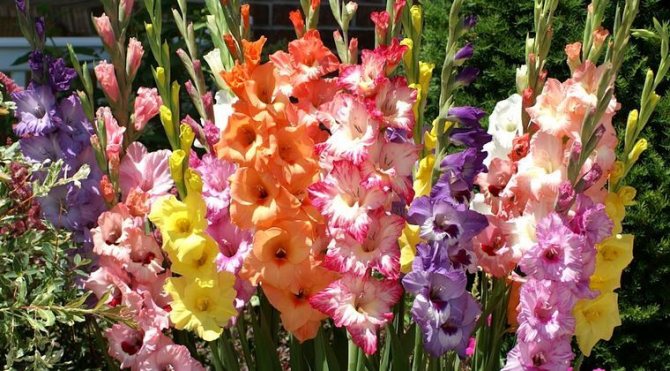

Gladiolus varieties
Gladioli care
Conventionally, all cultivated gladioli are divided into 3 large groups:
Wild gladioli
In floriculture they use:
- Marsh gladiolus up to 60 cm high with small dark purple flowers. Loves wet places. Tubers hibernate without digging under cover.
- Gladiolus Byzantine (G. Bizantinus, G. Elatus, G. Grandiflorua) is a frost-resistant type. The flowers are small, purple with a transition to crimson with a white vein.
- Gladiolus Kochi blooms in spring. The inflorescence is short, lilac-pink.
- Gladiolus ordinary reaches up to 1 m in height. Purple-violet flowers are medium-sized, densely planted. It is thermophilic, therefore it is grown outdoors in the southern regions.
- Gladiolus seed. Its height is up to 80 cm. The typical color of the petals is light lilac or pink, other colors are less common.
- Gladiolus tiled is a frost-resistant species, the flowers of which are painted in pinkish-lilac tones.
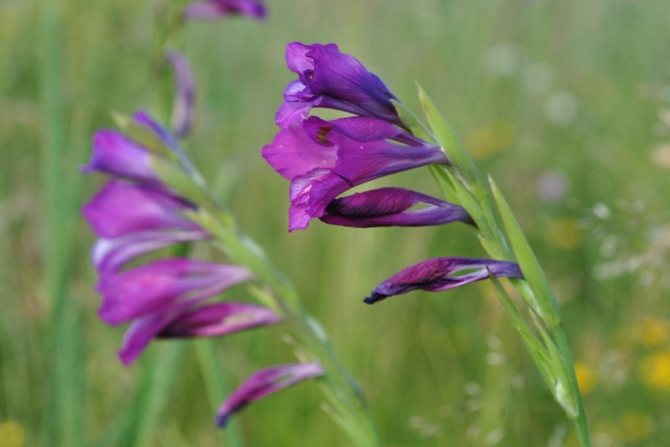

Wild gladioli
Cultural gladioli
There are 6 hybrid species:
- Colville's Gladiolus is an early flowering type with small flowers on a 90 cm stem. The typical color of the petals is white, pink, crimson.
- Gladiolus Harlem. Its flowers on a fragile stem open in early summer. The color is varied.
- Gladiolus dwarf is a Dutch hybrid (nanus, mini gladiolus), barely reaching 40 cm in height. Coloring of light colors with dark specks-rhombuses in the core.
- Gladiolus Tubergen of Dutch selection is distinguished by narrow leaves, about 75 cm high and a wide variety of corolla colors.
- Gladiolus primrose, rarely used as an ornamental.
- Hybrid gladioli are almost all varieties found in horticulture. Their height is from 90 to 200 cm, the size of flowers is from 5 to 20 cm, the number of inflorescences can reach 20 pcs.
The most popular varieties of hybrid gladioli are divided into color groups:
- Red gladioli: Traderhorn, Shaka Zulu, Halisi, Oscar, Bimbo, Great temptation, Stereo, Zizani, Baccarat, Black Sea, Espresso, Mystery of the night, Red Square, Africa, Black surprise.
- Burgundy: Black Velvet, Arabian Nights.
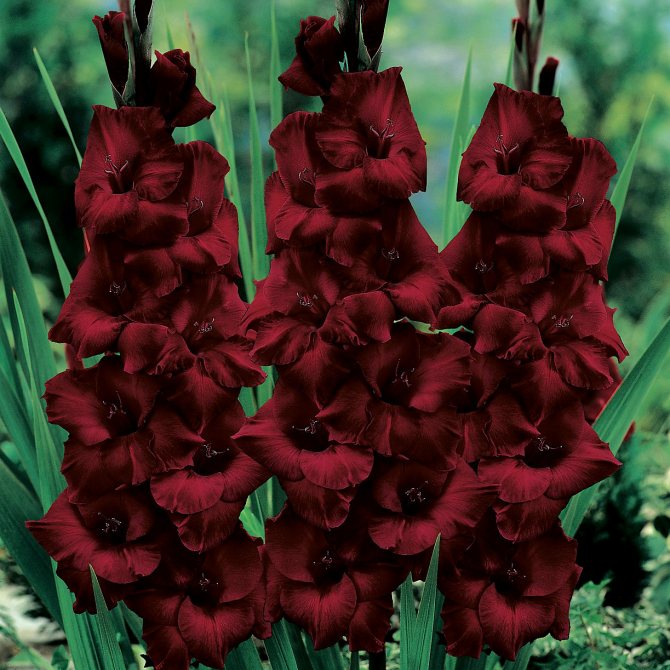

Burgundy gladioli
- Pink: Priscilla, Katerina, Malika, Fidelio, Dandy, Dew in an emerald, Rose Supreme, Pink Lady, Countess, Orlando, Prague, Mon Amour, Gagarin's Smile.
- White gladioli: White Prosperity, Fiorentina, Bangladesh, Sea Queen, White Vertical, Snowy Frizl, Dmitry Solunsky, Tampere.
- Crimson: Plumtart, Jo-Joe, Royal Spier, Crimson streamer.
- Greens: Green Star, Fergie, Radiant Greens.
- Salmon, orange: Grand Duchess Elizabeth, Lace bow, Golden wedding, Maya Plisetskaya.
- Yellow gladioli: Jester, Nova Lux, Lyim Light, Vladimir, Izuminka, Victoria, Yellow.
- Lilac and purple: Passos, Volbit, Dynamite, Valencia, City of Kitezh, Anuk, Violetta, Chemistri, Grand Pass, Sadko, Tango.
- Brown, smoky: Chocolate girl, Charming berry, Yakutsk, Chocolate, Bukkako, Torino.
- Blue: Blue Blizzard, Blue Butterfly, Sweet Blue.
- Blue: Gates of Heaven, Blue Pool, Starry Knight, Magdalena.
- Black Gladiolus: Ebony Beauty.
Brief description of cultivation
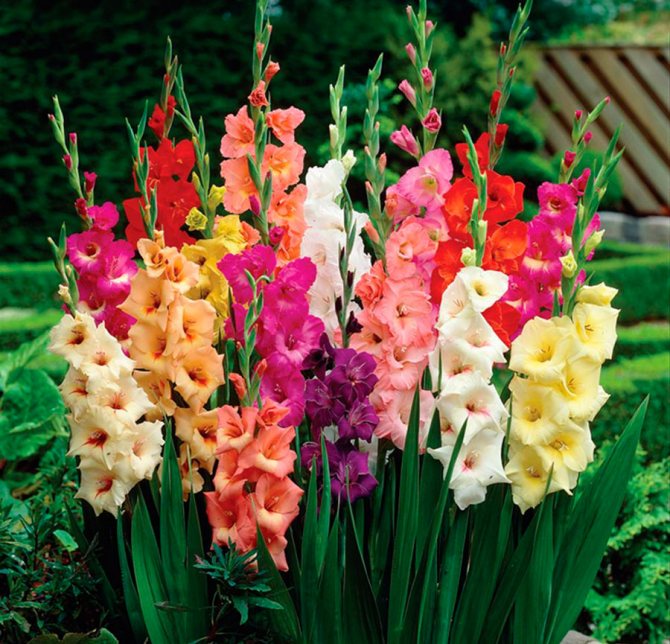

- Bloom... From the first weeks of summer (early varieties) until the beginning of the autumn period.
- Landing... In the springtime.
- Digging out the bulbs... From early to mid-autumn.
- Storage... In a cool place (5 to 10 degrees).
- Illumination... Needs bright sunlight.
- Priming... Sandy loam, structural black soil or light loam. The soil should be slightly acidic (pH 6.5 to 6.8).
- Watering... It is watered on average 1 time in 7 days very abundantly (per 1 square meter of the plot from 10 to 12 liters of water).
- Fertilizer... They use liquid mineral fertilizers and organic matter. Top dressing on foliage is carried out at the beginning of the growing season and during the formation of buds, and the root: the first - during the formation of 1 or 2 true leaf plates, the second - during the development of 5 or 6 leaf plates, the third - before the buds begin to form.
- Reproduction... Seed and vegetative (corms and buds).
- Harmful insects... Thrips, meadow mites, cabbage scoops, wireworms, bears, slugs.
- Diseases... Fusarium, gray rot, sclerotiniasis, septoria, bacterial scab, cancer, penicillosis, curvularia, smut, viral diseases.
Features of planting and care
The cultivation of a skewer involves several stages, starting from the preparation of tubers and ending with laying for storage, which is done every year, akin to annual plants.
Preparing gladioli for planting
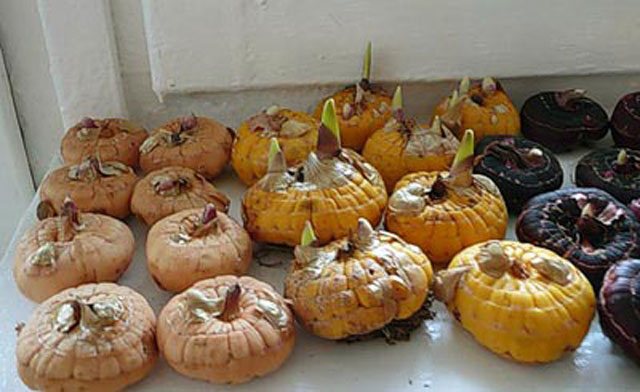

Preparing gladioli for planting
All about dahlias
Preparation is a long process that begins 3 weeks before the planting date. Tubers are taken out of storage, examined, healthy ones are separated from those that have been damaged or that have dried up over the winter. In order to avoid mistakes during sorting, the planting material is peeled from the husk.
Important! Onions, on which lesions were found (spots, dry crusts, weeping places), are cleaned, coated with brilliant green, dried. The material selected for planting is laid out on pallets in one layer and kept at room temperature for 18 days, accelerating the awakening.
Then the corms are disinfected, laid out again on a pallet with a damp pad of cotton wool or moss. So they keep them for 3 days, preventing the wet layer from drying out.
Note! It is advisable to sort by size before planting. Very large ones will release powerful peduncles, which will take over the lion's share of light and nutrition, so they are planted separately.
Bulbs purchased from reputable sellers in person or with delivery by mail go through all stages of preparation.
Disembarkation dates
Factors Favorable to Planting:
- stable soil warming up to 10 ° С at a depth of 10-12 cm;
- the soil is dry enough after the snow melts.
The approximate dates of planting are in April - the first ten days of May.
Landing place
For gladioli, they choose sunny areas where rainwater does not stagnate. An additional important condition is protection from the wind, the gusts of which can break long peduncles.


Preparing the soil for planting
Ideal if the landing site was prepared in the fall. In spring, this can be done 2 weeks before planting the bulbs. Digging, loosening, fertilizing for bulbous plants - this is enough for a regal flower.
Note! The most suitable soil for gladioli is black soil, sandy loam or loam, neutral or slightly acidic.
Planting depth
Depending on the size of the corms, they are planted to a depth of:
- large - 10 cm;
- medium - 7 cm;
- small - up to 3 cm.
Watering
Before the appearance of peduncles, the timing and amount of watering is determined by the state of the soil, since spring and the first half of summer are often accompanied by precipitation.Three or four fully formed skewer leaves mean that the peduncle has already been laid, so the watering is increased to 15 liters per 1 m². Flowering plants require even more moisture, while after irrigation they loosen the soil, scoop it up to the base of the stem.
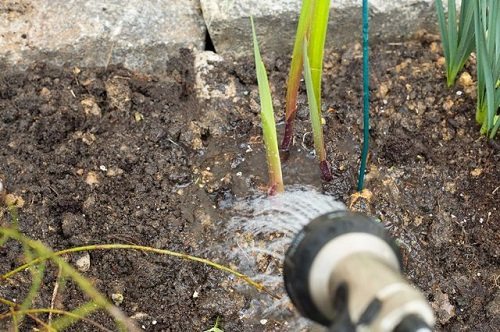

Watering gladioli
Top dressing
The first feeding is carried out a month after planting the tubers. At this stage, add ammonium nitrate or urea at the rate of 30 g 1 m². The second time is fed during the formation of buds. It is optimal to use a complex fertilizer for flowering or specialized.
Garter
Peduncles of medium and tall varieties are tied to pegs when they are equal in height to the leaves. If for some reason it is difficult to install supports, the flowers are spud up to a height of at least 12 cm.
Storage preparation
The buds that have faded are cut from the stem. The leaves are left so as not to deprive the corm of nutrition.
On a note! Dug up the bulbs in the fall, when the tops turn yellow and begin to dry out. The extracted material is freed from the ground, the daughter bulbs are separated from the main one, and laid out to dry.
Planting material is stored in a cool dark place, packed in paper bags, ventilated every 10-15 days.
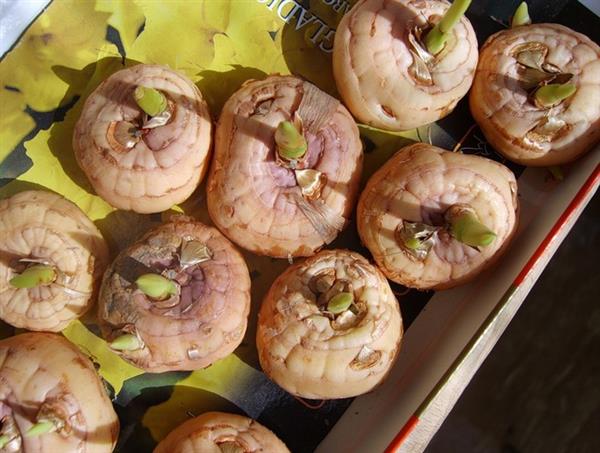

Storing the bulbs
Basic rules for growing
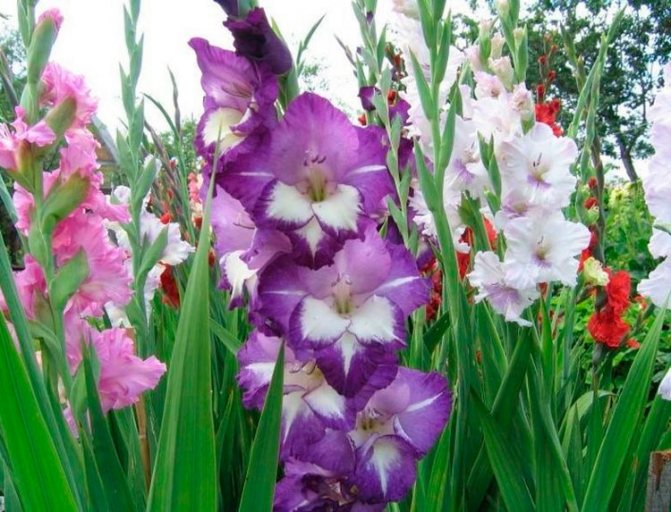

Before you start growing gladiolus in your garden, you need to familiarize yourself with the 11 most important rules that will help you grow healthy plants with beautiful flowers:
- It is impossible to grow such flowers in the same place for more than 2 years. In the third year, a different place is chosen for their planting.
- During the transplant of gladioli, you need to try to choose a site whose soil composition will differ from the previous one. For example, if flowers were grown in light black soil, then they can be planted in sandy loam soil.
- Purchase the planting material that has been adapted to the climatic conditions of your region. This is due to the fact that these flowers react extremely negatively if they get from a warm climate into a damp and cool one. When purchasing planting material from Holland, remember that such gladioli will bloom magnificently and very effectively, but only once.
- Large bulbs should not be planted near children, as they will oppress them. It is recommended to plant in order: from small to large bulbs. Experienced gardeners recommend choosing the largest corms and planting them separately.
- It is very important to plant the corms at the correct depth. In heavy soils, the bulb is planted to a depth equal to 3 of its diameters, and in light soils - four. If the bulb is buried very deeply in the soil, then this can cause the lack of flowering. And if it is not deepened to a deep enough depth, then an arrow garter may be needed.
- When 3-5 days remain before the daughter bulbs are planted in open soil, it will be necessary to remove dense scales from them, otherwise the sprouts may not appear. When they are planted, they are watered once every 2 days.
- This is a light-loving plant. If the late variety is grown in a shaded place, then you can not wait for its flowering at all. However, early varieties, if desired, can be grown in a shady or semi-shaded place, but in this case the bushes will bloom much later.
- The area where flowers grow must be ventilated, otherwise the bushes can infect fungal diseases.
- If the flowers are grown in sandy loam, then they must be regularly fed on foliage.
- In the summer, the bushes should be watered about once every 7 days, but at the same time abundantly enough. During a long dry period, they are watered daily in the evening, after which the surface of the soil is loosened, bushes are huddled and weeds are pulled out.
- Dig up the corms and store them correctly, and you should pay special attention to this.
Diseases and pests
The main pests of gladioli are slugs and bears that eat up stems and bulbs. Only specialized drugs that are introduced into the soil, for example, medvetox, are saved from the bear.
Important! Fighting slugs with chemicals is undesirable, since toxic substances harm small living creatures in the area, including domestic animals. To protect flowers from their invasion, prickly mulch - needles, eggshells, as well as mustard powder, ground hot pepper helps.
All diseases characteristic of the skewer - fungal, bacterial, viral, unfortunately, appear very late, when irreversible processes are already taking place in the bulbs, why it is pointless to fight them. The only measure of protection is strict adherence to the rules of agricultural technology, proper care, disinfection of the planting material, and tillage before planting.
Choosing healthy bulbs
Gladiolus bulbs
First of all, decide on your climatic region and soil, get suitable planting samples for you. Fortunately, a variety of varieties will only help you.
Remember that gladioli are sun- and heat-loving flowers; if you live in the cold northern regions, growing them outdoors can be problematic.
An excellent solution would be long and deep pots or tubs, which can be placed in a sufficiently lit room with a warm climate.
This can be an insulated balcony or a closed veranda, preferably with sufficient time to absorb the sun's rays. After all, Gladíolus is, first of all, a "sun flower".
- Gladioli in the country
When buying onions, pay attention to their appearance. They must be large enough to maximize acclimatization. It should look healthy, free from signs of diseases and pests. - Be sure to keep all young babies and plant them constantly, they will serve as excellent breeding material. Some babies, large enough, even bloom in the first year of planting.
- Examine the corms, if some are dry or become too soft, mold or sores have appeared, such specimens are not suitable for planting.
- The soil temperature should warm up to no less than + 10 ° C (approximately April, May).
- Spread out in a bright, warm room in one layer, so that they wake up and grow. If suddenly, a sharp cold snap has come, and there is no way to plant the sprouted onions, transfer them to a dark, cool room, you can even go to the refrigerator.
- It is recommended to leave one sprout, so the shoot will turn out stronger, the secondary ones can be broken off or cut off, and the sections can be lubricated with brilliant green.
- Whatever healthy tubers are, they should be treated with a manganese solution, placed in it for 9-12 hours, you can overnight.
Gladiolus in landscape design
From a design point of view, gladioli in the garden are rather uncomfortable. In a single fit, they lose their royal grandeur, in a group they resemble a gypsy skirt. The most traditional company in the garden for him is multicolored phlox, decorating the seemingly bare stems of gladiolus.
A common solution is small, compact gladularia (the so-called flower beds from some gladioli), placed in large pots or islands in flower beds, carefully selected in color and height. A beautiful frame will be relatively low flowers "waist-deep" to a group of gladioli, blooming before or after it.
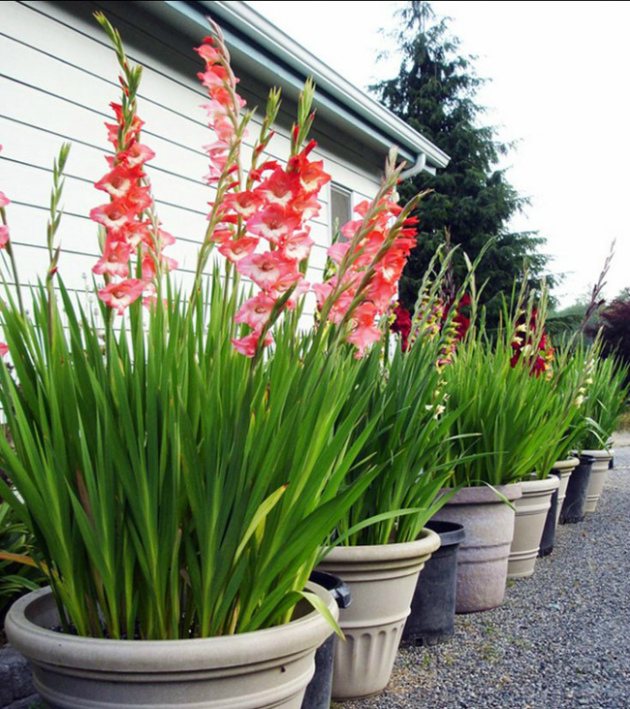

Gladiolus in landscape design
When planting in groups, no more than 15 skewers of various, but harmonious colors are planted nearby. When decorating dwarf or medium-sized borders, it is recommended to use small groups, emphasizing their beauty with ground cover and undersized flowering or decorative leafy neighbors.
Note! A mix of representatives of different species or varieties does not cause concern. The specimens blooming at the same time are likely to be pollinated, which does not matter, since the genetic set of varietal traits is stored in the bulb. But for lovers of experiments, the seeds of such flowers will add variety. The new plants will have their own characteristics, including the color spectrum.
Advantages and disadvantages of colors
Bright luxurious flowers are a real decoration of the garden. The corrugated flowers are especially beautiful. One flower is already a bouquet. Looks great in a flower bed and in a cut. In addition to the extraordinary beauty, gladioli have some disadvantages:
- very whimsical to care for, require a competent irrigation system,
- tall flowers must be tied up,
- susceptible to disease
- very thermophilic
- complex care of the bulbs collected for storage,
- degeneration of the variety.
How to keep a bouquet of gladioli fresh
Quite often, summer residents grow a skewer for cutting. This is understandable, since it is difficult to imagine a more solemn bouquet. To make fresh flowers stand longer, use simple techniques:
- Activated carbon, aspirin, sugar, salt, citric acid are added to the vase.
- Scratching the stems to increase the moisture-absorbing surface.
- Change the water regularly.
- Remove wilted flowers.
The popularity of gladioli knows no bounds. His name is even assigned to the characters of popular computer games (Gladiolus Amicitia). A huge selection of hybrid varieties with a wide variety of colors, from delicate monochromatic to spectacular multi-color, the multivariance of flower arrangements pays for some of the difficulties of growing.
Reproduction
Children of gladioli
Seed propagation is not recommended due to possible loss of grade.
In general, gladioli reproduce from children or by dividing tubers.
- Reproduction by children begins with collection, when you carefully separate all the children from the main bulb, carry out all the measures mentioned above. It is necessary to look to ensure that the roots and the upper part are intact, from which the stem will grow. Soak them in a strong manganese solution before planting.
- Bulb division is used mainly when very few new babies appear, or the variety does not produce them at all. And also, if you want to bring out a new variety of gladioli. The tuber is carefully cut so that the bud hits each part. After all, it is from the buds that sprouts will go.
Brown
These are some of the more exotic gladiolus hybrids. They impress with unrealistic shades, the creation of which has become an incredible achievement of breeders.
Chocolate
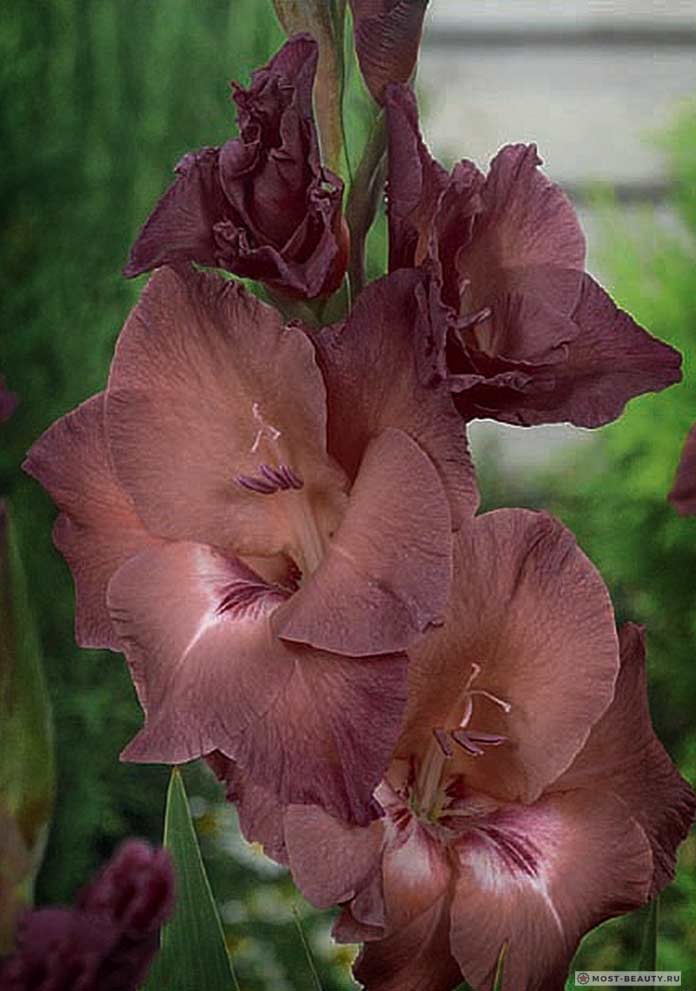

Chocolate is a real explosion of bright drops from the artist's palette. Here milk-chocolate, caramel, burgundy and pink-orange blotches are intertwined. The most saturated shades prevail on the corrugated edges of the petals.
Ancient magic
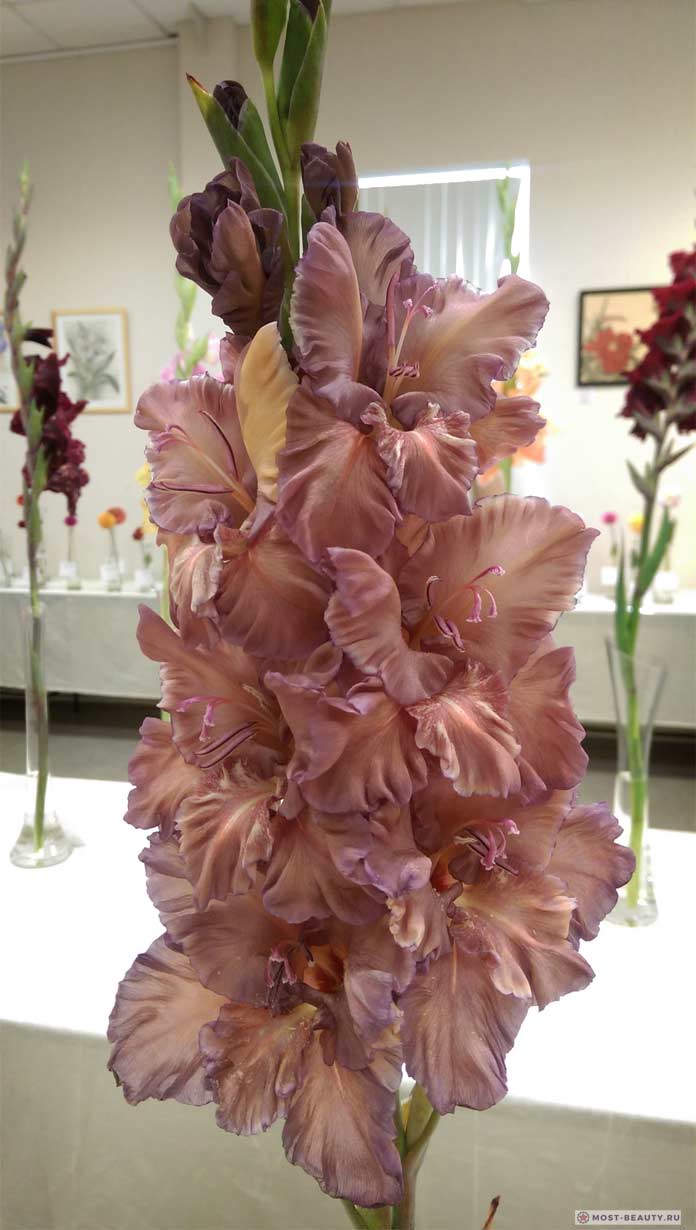

Ancient magic is another fascinating member of this group. It impresses with the bizarre shapes of the petals and their amazing light brown color with overflow of many shades. At the edges, the flowers have a lilac haze, and their central veins have a bright crimson color.
Fragrant gladiolus - herbaceous plants for open ground
A perennial plant native to Africa, it lives in nature on rocky slopes. He has a high peduncle with two xiphoid leaves with sharp ends. Planting fragrant gladiolus acidants and care should take into account that their root system is small, and it is covered with a sheath in the form of a mesh. Spikelet-shaped inflorescences produce up to 10 flowers, the beauty of which can be enjoyed from August to September. Fragrant gladiolus has a pleasant sweet aroma. In the fall, seed pods form in place of flowers.
Yellow-cream
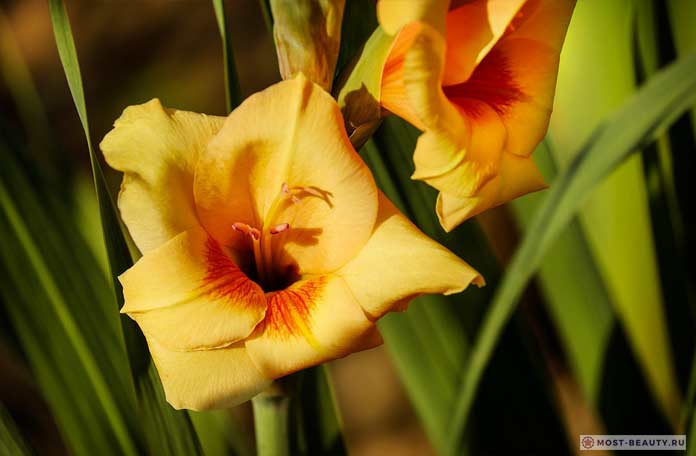

These varieties are like flashes of sunbeams shimmering in the reflection of the water surface.Exceptionally golden-sunny colors are rare (for example, the Temple of the Sun and Golden Lace). Usually yellow color is diluted with cream, orange and even light green tones.
Golden Fantasy
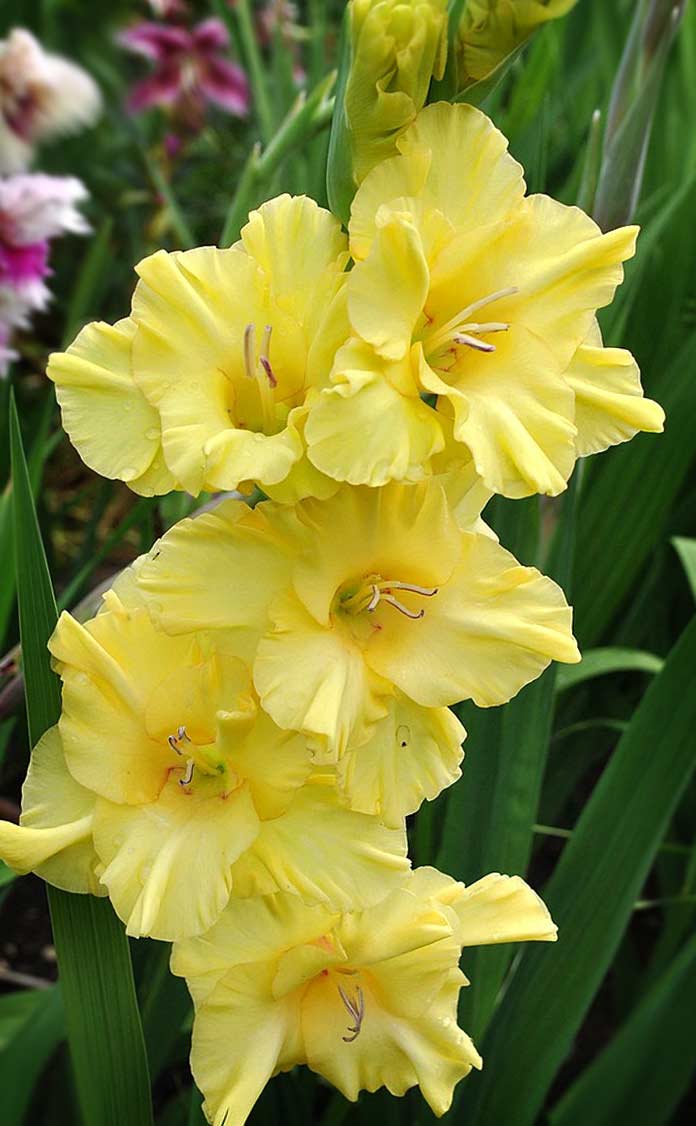

The hybrid variety Golden Fantasy created by the Dutch impresses with its long stems and an abundance of two-color buds. A very early variety.
Quadrille
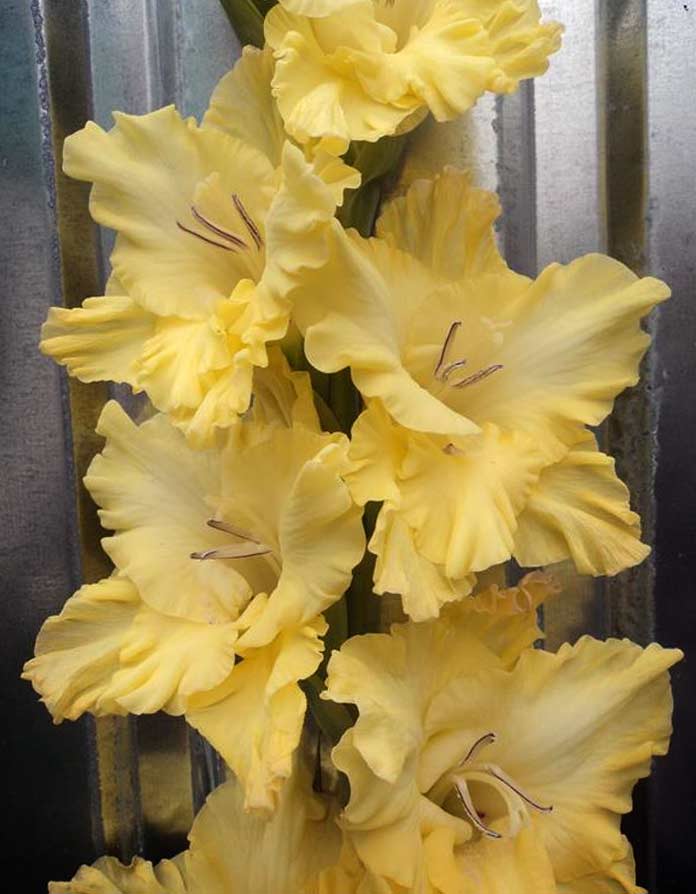

The square dance is distinguished by a combination of yellow-cream shades and the presence of a red speck at the bottom.
Halloween
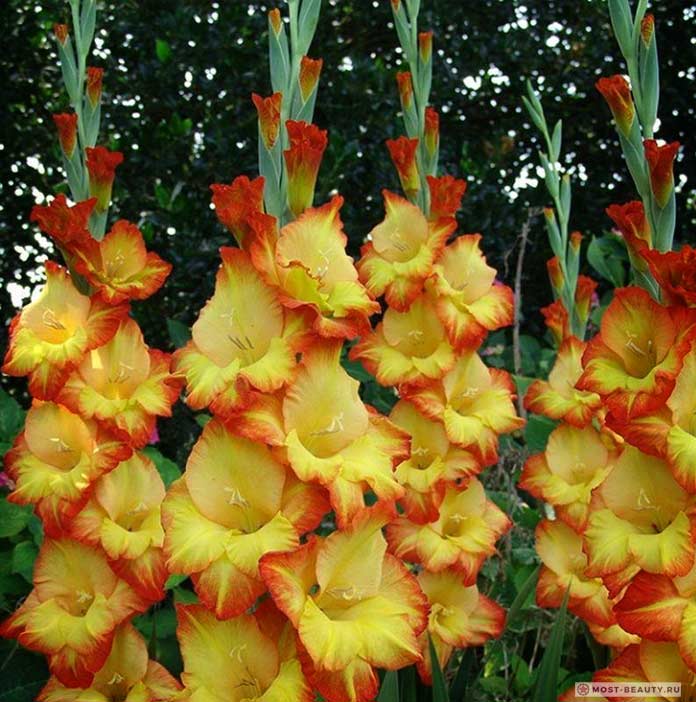

Halloween is the most impressive variety, with a long bloom from mid-summer to late September. The flowers are deep yellow and have a colorful orange edging.
Lilac-lilac
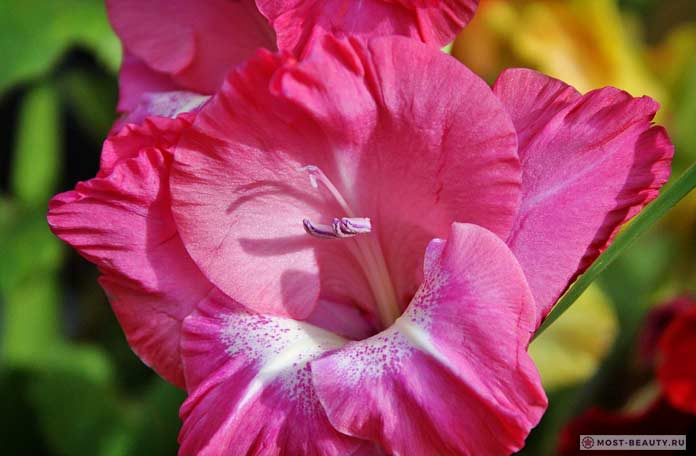

Representatives of this group are no less popular than red flowers. They fascinate at first sight. Their violet, lilac and lilac gamut is associated with a special magical attractiveness and a share of mystery.
magical flute
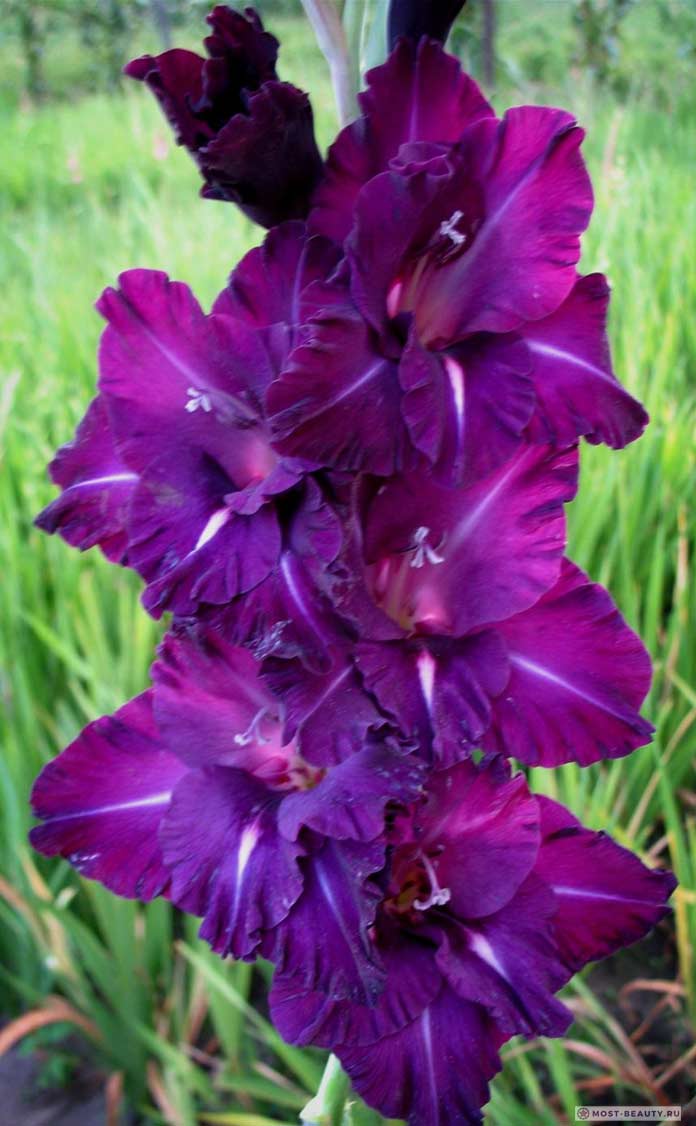

The Magic Flute is a variety with large pointed flowers, more like a star. It is painted in a dark purple range, but has a snow-white stripe along the edges, which gives it an original look.
Guest from the future
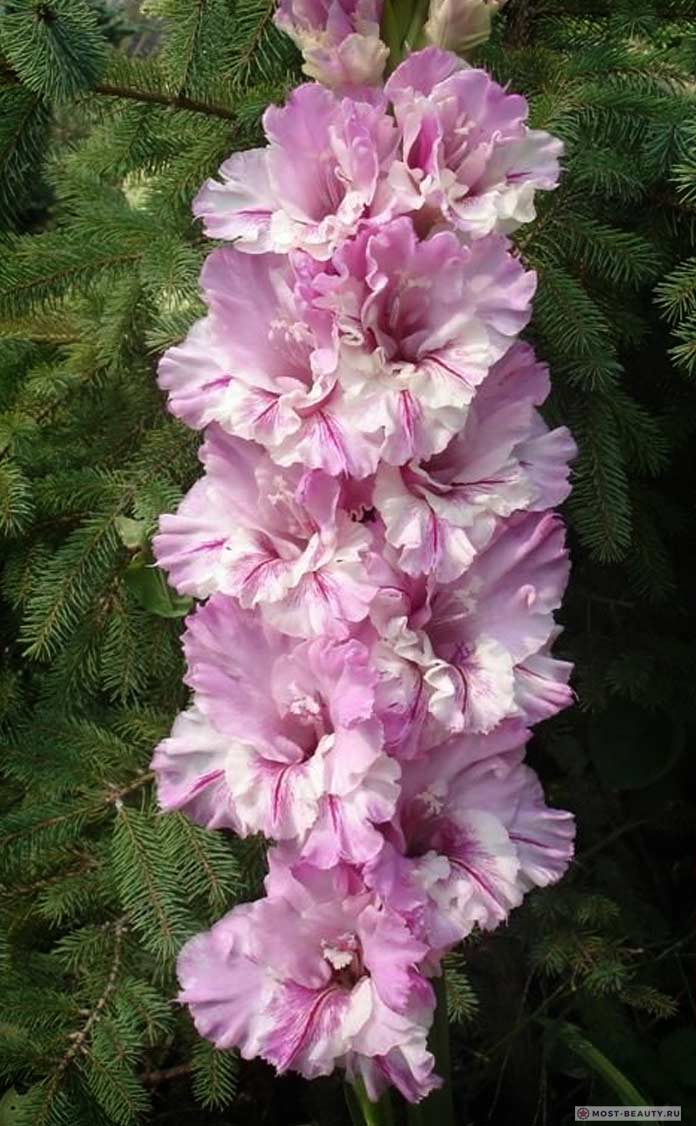

Guest from the Future is a relatively new hybrid created by Russian breeders. It blooms in August-September with delicate lilac flowers, along the edges of which darker shades appear.
Black Velvet
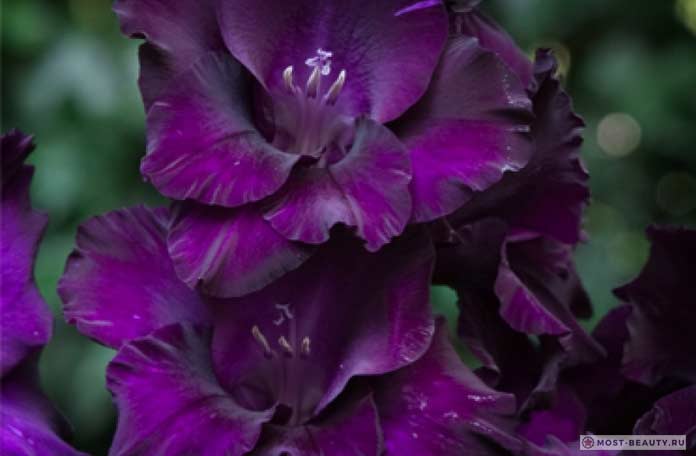

Black Velvet is distinguished by large inflorescences with a dark purple color of velvet petals, slightly wavy at the edges.
History
It is believed that the name of this plant was given by the legend of two noble gladiators. In a fierce war between the Romans and the Thracians, the Roman commander took prisoners and, for the entertainment of a curious audience, forced them to fight to the death among themselves. The winner in the duel was promised freedom. But for the two Thracians, this was not only a struggle for life, but also the most difficult choice. Having made friends in trials far from their homeland, they could not raise their swords against each other. Having stuck them crossed into the ground, they embraced and both accepted death from the unsatisfied bloodthirsty crowd. In the place of their swords, beautiful tall gladioli took root and sprouted, reflecting true male friendship, courage and loyalty.
The second common name for this plant is "skewer". It symbolizes the similarity of the shape of the leaves and combat swords.
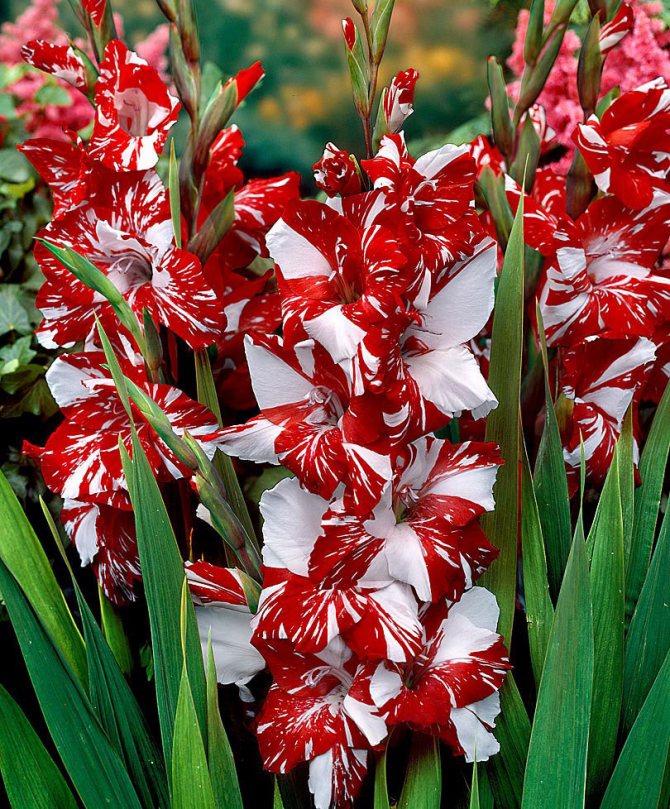

Gladioli
Amber colors
The varieties with a fiery range of flowers are some of the most fascinating. Even in the photo, these gladioli seem like a truly magical masterpiece of breeders.
Honey Savior
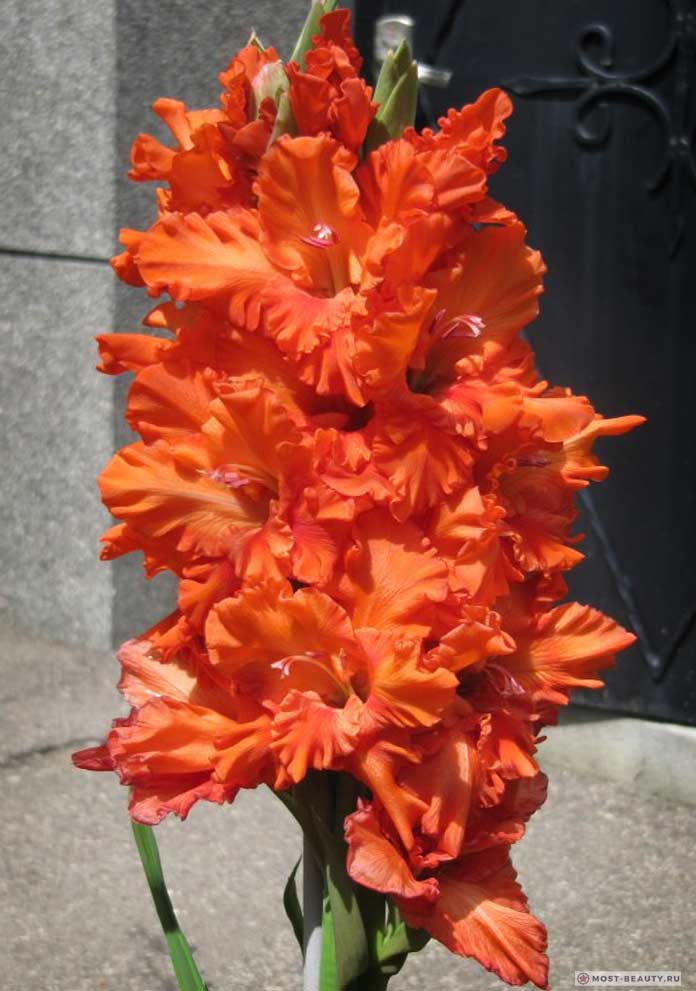

Honey Spas is distinguished by its bright orange color with a slight red speck. Large buds bloom in mid-August.
Nizhny Novgorod
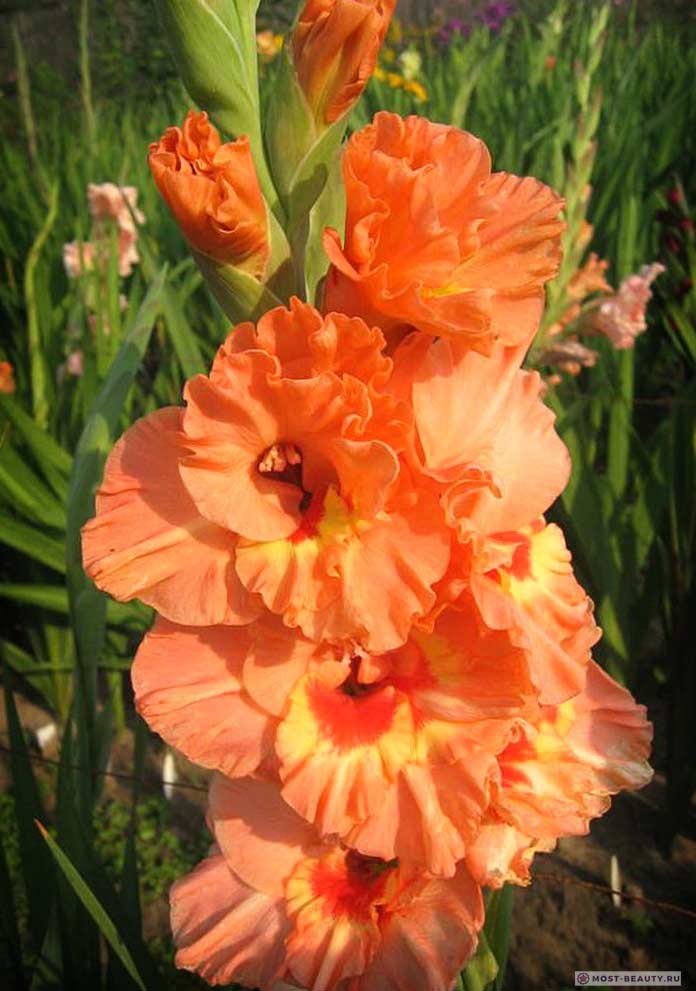

Nizhny Novgorod is dissolved by September 1. Its openwork petals are painted in orange-brick shades, and in the lower edge there is a red speck with a golden border.
The choice of planting material
The best bulbs for planting are round, shiny, without visible damage or spots, with a bottom diameter of 3 to 7 mm.
You should not buy large corms with a concave bottom, they probably have already bloomed more than once, so they will not form a good inflorescence.
The presence of three or more sprouts does not at all indicate the strength of the bulb, but the presence of an incurable disease - herbaceousness.
Red spots sprinkled with purple powder indicate that the planting material is infected with thrips, and shiny round brownish spots indicate that the bulbs are infected with bacterial scab.
If brown spots cover the bottom - this is fusarium, such bulbs must be destroyed.
Pink
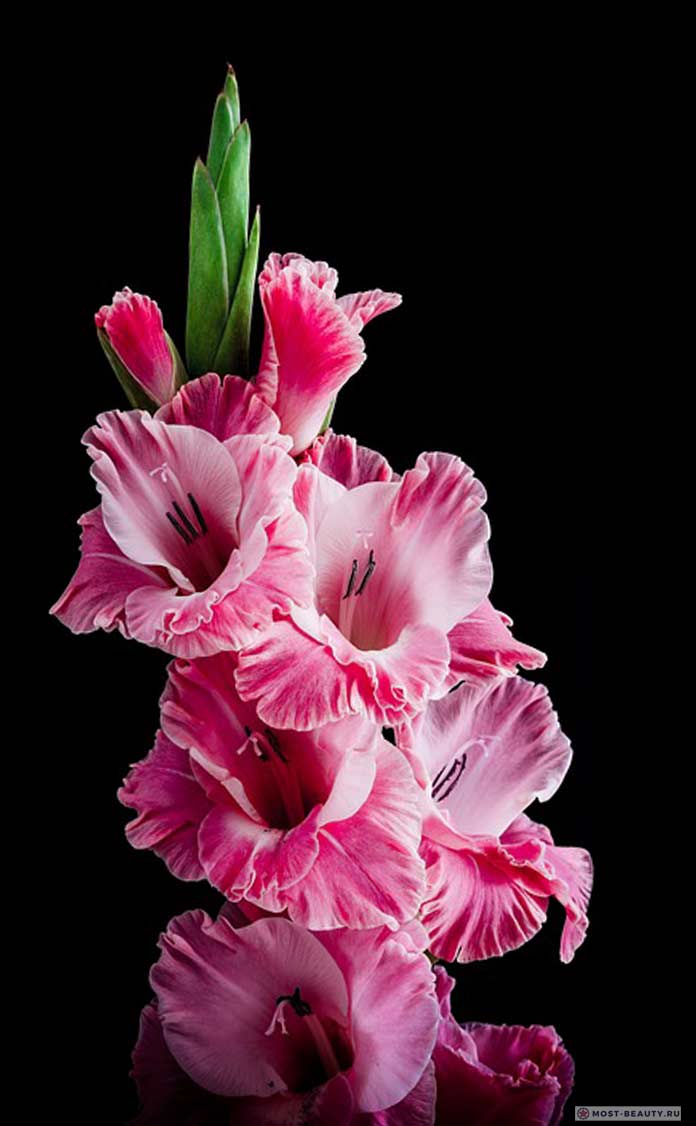

The color in this group can range from light pink to rich crimson and coral shades.
"Merchant" and "Boyarynya"


in the photo: variety Kupets
The “Merchant” is reminiscent of delicate tea roses in color, and “Boyarynya” is distinguished by the colorful petals of coral-colored buds.
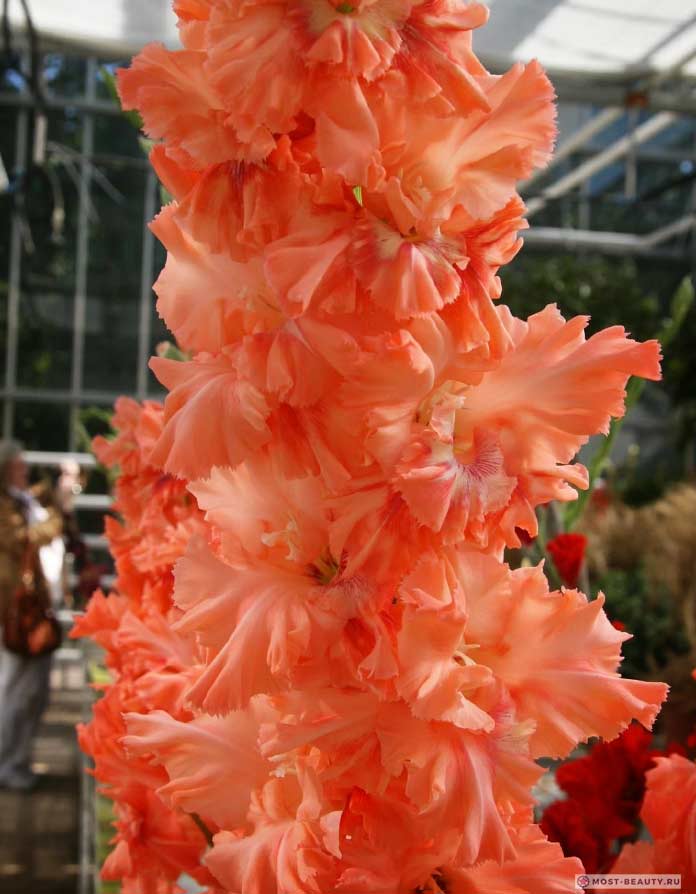

In the photo: Boyarynya
"Nevskaya exotic"
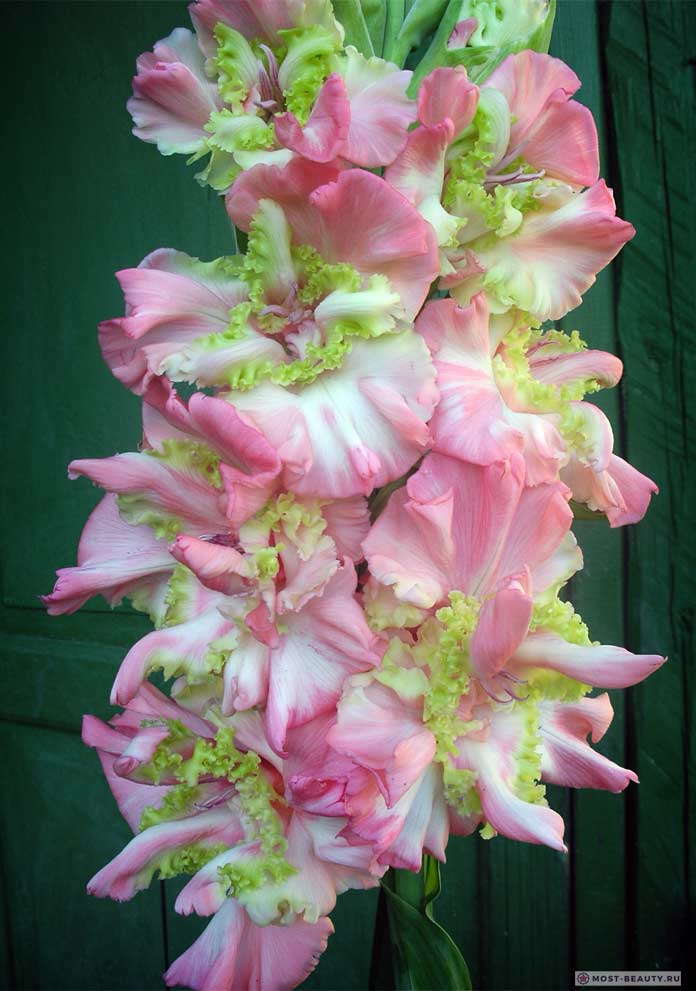

"Neva exotic" in this group is considered one of the most curious varieties. Her petals are light pink with snow-white edging and a fringe of light green shade.
"George Soros"
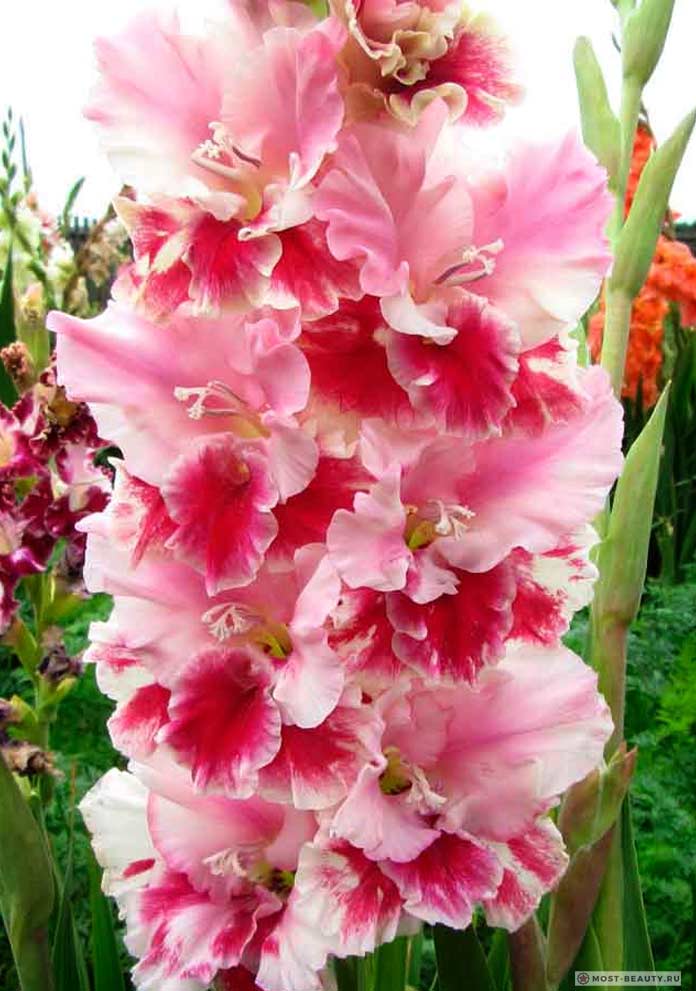

"George Soros" is an unusual corrugated gladiolus, in which pink, crimson and pale lilac shades wonderfully coexist. A very effective variety, but quickly loses its brightness in the sun.






